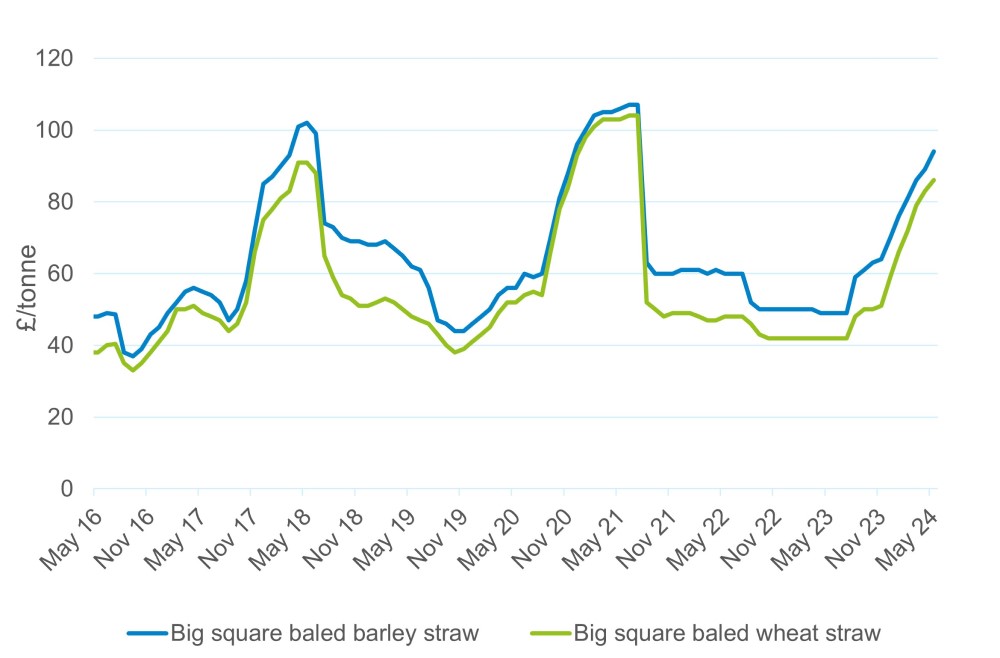- Home
- Knowledge library
- Is it better to incorporate or sell straw?
Is it better to incorporate or sell straw?
Here we examine the pros and cons associated with the decision to either incorporate or sell straw. Armed with a better understanding of the monetary and non-monetary implications, it will help you decide on the best option for your farm business.
How much nutrient is your straw? RB209 has the answer!
Straw: chop or shop? Results from our straw incorporation review
Straw markets include renewable energy systems, horticultural production (e.g. carrots and mushrooms), in addition to more traditional livestock-sector use. At the same time, the incentives to chop straw have increased. There is no doubt that straw is both versatile and valuable, but deciding the best route for the product can involve a heady mix of economics and emotion.
Straw demand
Short-term price fluctuations are driven by demand surges: for example, spikes in animal feed and bedding demand during long, wet winters, and straw supply (both quantity and quality) impacted by weather, especially in wet years. Regionally, we will also see differences at play.
In the most recent five years, big bale straw prices remained supported mostly above £40/t, with spikes seen above £80/t and reaching over £100/t in 2021.

Source: British Hay & Straw Merchants' Association, Defra
Information on straw and hay prices
Straw incorporation pros and cons
Advantages
- Returns nutrients and organic matter to the soil
- Reduces nutrient and soil particulate loss
- Improves soil health (e.g. measured by earthworm numbers)
- Removes compaction risk associated with straw removal
- No delay in accessing the field for the next crop
Disadvantages
- Increases fuel costs
- Contributes to combine wear-and-tear costs
- Provides a ‘green bridge’ for some pests/diseases through crop residue
- Causes nutrient lock-up issues associated with crop residues
- Crop residue can limit in-field operations
Other points to consider
- Soils with low levels of organic matter (e.g. less than 5%) will respond more positively to incorporated straw, especially if no other sources of organic material are applied regularly on the farm
- Is the combine straw cropper and chaff spreader effective enough, especially with wide headers? Will raking be needed at extra time and cost?
- A short chop length will promote quicker decomposition but can lead to greater nutrient lock-up at the time of next crop establishment. Use the longest chop length possible, without compromising spread width, to reduce nutrient lock-up, save fuel, and reduce wear and tear
- Consider whether your cultivation/drilling equipment can deal with the residue, especially in wet weather
- Reduced cultivation supports worm populations and straw decomposition. Ploughing in poor conditions can bury straw into anaerobic conditions and slow/prevent decomposition
- With slug control options increasingly limited, it is essential to assess the risk from this pest to the following crop. Where risk is high, consider selling straw
Straw selling pros and cons
Advantages
- Provides useful cash flow from sale
- Facilitates easy entry for the following crop
- Reduces pest (including slugs) and disease pressure
Disadvantages
- Weather can interfere with plans (e.g. wet conditions can delay removal and reduce the window for establishment of the following crop)
- Risk of compaction (especially if operation needs to be carried out on suboptimal ground)
- Nutrients are removed from field
- Less organic matter is returned to the field
- Problems can spread from one field to another (e.g. weeds)
Other points to consider
- Be clear who is baling, carting, stacking and loading the straw. This includes understanding the capacity to clear fields (by farm staff or contractors) as harvest progresses
- Have an agreed policy on how to proceed if the weather turns ‘catchy’. Planning will help ensure fields are prioritised and reduce the risk of straw swaths being left to the weather. Know whether you can afford to delay the following crop, if straw is not removed as per the original plan
- Is the soil dry enough to handle removal of straw without excessive compaction? It is important to factor in the potential costs of compaction and soil restructuring associated with straw removal
- Large, high-capacity combines tend to leave straw in a ‘tight’ swath. This prolongs drying, particularly if the straw is not ripe
- Is a muck-for-straw deal available? But consider whether straw removal and the return of farmyard manure (FYM) is worth the compaction risk
- In Controlled Traffic Systems, extra thought on bale removal is required
- If the farm runs its own baler, calculate the cost of operation with the AHDB Machinery Costing Calculator
- When selling or buying straw, it is important to understand the quality of the product. Distribution of weed seeds, in particular, can be associated with straw use. Be sure you are aware of the risk
Nutrient content of cereal straw
Straw contains significant amounts of potash, and some phosphate and magnesium. Typical values of phosphate and potash contained in straw are published in Section 4 of the AHDB Nutrient Management Guide (RB209). This information can be used to calculate the equivalent market value of nutrients. These figures can be used alongside non-monetary measures, such as attitudes to risk (e.g. compaction risk), to make a final decision.
RB209 for arable crops (section 4)
Rape straw and herbicides
If oilseed rape straw has been sold, it is important to check which herbicides, if any, were applied to the crop. The active ingredient aminopyralid can remain manure and affect crops on land where it's spread – so check herbicide labels and seek advice from an agronomist.
The use of straw for animal bedding
Straw is the most frequently used bedding material. It has good thermal properties and moderate absorption capacity. Barley, wheat and oat straw are the most commonly used, although rye and triticale straw may be available in some areas.
The bedding materials directory
Related content
Topics:
Sectors:
Tags:


